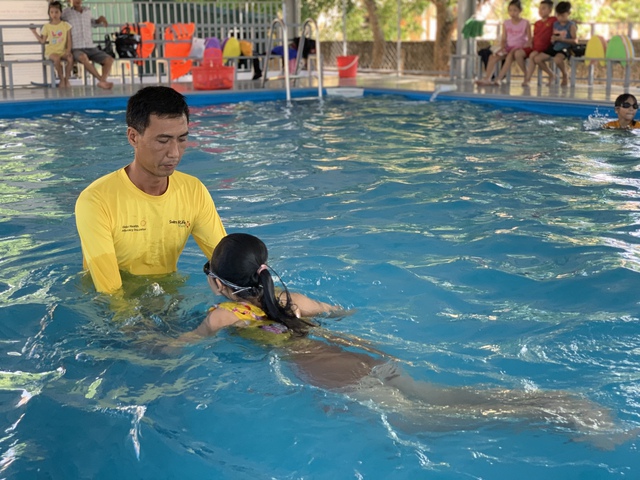Urgent call for stronger action to prevent child drowning in Viet Nam
VGP - On the occasion of World Drowning Prevention Day (July 25, 2025), the Department of Maternal and Child Affairs under the Ministry of Health, the World Health Organization (WHO), and the Campaign for Tobacco-Free Kids (CTFK) jointly called for stronger and more coordinated efforts to protect Vietnamese children from drowning.

A child takes part in a swimming safety class aimed at preventing drowning in Viet Nam
Despite progress in recent years, drowning remains a leading cause of death among children in Viet Nam, especially those aged 5 to 14. The pace of reduction in child drowning fatalities has not met expectations, prompting renewed calls for urgent, multisectoral action.
This year's theme, "Together, let's act so no more children drown," underscores the need for collective efforts across all levels of society — from individuals and families to communities, schools, and authorities — to reduce child drowning risks.
According to WHO, an estimated 300,000 people drown each year worldwide. Of these deaths, 57 percent involve children and young people, and 92 percent occur in low- and middle-income countries. In 2021 alone, Viet Nam recorded 4,019 drowning deaths, with 40 percent of victims being children under 14.
Data from the Ministry of Health shows that nearly 2,000 children die from drowning each year. Although this rate is on a downward trend, Viet Nam remains among the countries with the highest child drowning rates in the Western Pacific region.
Dr. Tran Dang Khoa, Deputy Director General of the Department of Maternal and Child Affairs, said: "Viet Nam has made meaningful strides in child drowning prevention, but serious challenges remain. The Ministry of Health has issued a directive urging provincial and municipal authorities to prioritize resources, implement proven interventions, boost public awareness, and enhance multisectoral coordination."
He added, "Every drowning death is a preventable tragedy. We call on parents, schools, communities, and local leaders — especially in rural areas with abundant ponds, rivers, lakes, and streams — to take stronger, proactive measures to keep children safe."
On this occasion, the Ministry of Health and its partners called on the Government to increase investment in child drowning prevention, particularly in high-risk areas; enhance public education on water safety, child supervision, and first aid; expand school and community swimming and water safety programs; strengthen national and international collaboration; and integrate drowning prevention into sustainable development policies.
Dr. Angela Pratt, WHO Representative in Viet Nam, stated: "Every drowning death is one too many. Drowning can happen to anyone, but no one should drown. Proven, low-cost interventions exist, and scaling them up can save lives and make our communities safer."
Ms. Doan Thu Huyen, CTFK Representative in Viet Nam, emphasized: "Drowning happens in just moments — but with awareness and timely action, it can be prevented. Those moments can be the difference between tragedy and survival."
Effective measures recommended for local authorities include: installing barriers around water hazards; ensuring lifeguard presence at public swimming locations; training communities in rescue and resuscitation; strengthening search and rescue capabilities; and providing free, accessible weather alerts to keep communities informed.
At the individual and family level, key preventive steps include: teaching children how to swim; supervising children closely around water at all times; checking weather and water conditions before swimming or boating; and staying informed about water safety risks.
Thanks to strong government leadership and the support of partners like Bloomberg Philanthropies and CTFK, thousands of children in Viet Nam have completed survival swimming courses and learned critical water safety skills.
WHO has also supported Viet Nam in developing and implementing key national frameworks, including the National Program for the Prevention and Control of Child Injury (2021–2030) and the Multisectoral Collaboration Plan on Child Drowning Prevention (2022–2030).
Based on global best practices, WHO's recommendations for preventing drowning include: developing national prevention strategies; promoting public awareness; strengthening data collection; and ensuring cross-sector collaboration to drive lasting change./.
